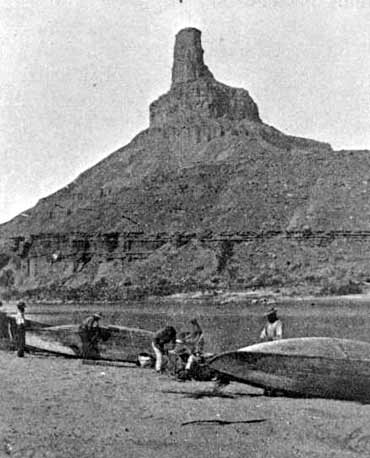What do you do if you are curious, adventurous, and scientific, and you know of a place that hasn’t been explored scientifically? You go there.
In short:

Of course, Indian groups had been living near the Colorado River and traveling up and down it for thousands of years. But John Wesley Powell led the first Anglo expedition to float from Green River, Wyoming, through the Grand Canyon.
In 1871 he did it again. During these two expeditions, he gathered geological, geographical, biological, and ethnographic information.
More of the story:
Powell, a Civil War veteran, scholar, and professor, began exploring the mountains, canyons, and rivers of the Rocky Mountains in 1868. His goal was to collect specimens and scientific information for a natural history museum.
To gain more knowledge, he decided to enter the last truly unknown region in the U.S.: the canyons of the Green and Colorado rivers. In the summer of 1869, ten inexperienced boatmen on four boats floated off from Green River in Wyoming.

900 miles and three months later, they would exit the Grand Canyon.
This was no picnic!
Today, people boat the Colorado on rubber boats or lightweight dorries. But Powell’s expedition had only heavy wooden boats—loaded with
food, scientific instruments, and cooking and camping gear. When they reached the huge rapids on the Colorado, they could choose either to run the rapids or carry all the gear around by land. They “lined” the boats through the rapids—standing on land while holding ropes attached to the boats as they went through the whitewater.
The group ended the trip with two boats and six people. (Four men had enough of danger and decided to quit during the trip. Ironically, three of these were killed by Indians or whites after they climbed out of the Grand Canyon.).

After the expedition.
Powell repeated the expedition in 1871-72. Renowned as one of the great adventurers and scientists of his day, Powell became the second director of the U.S. Geological Survey. He set forth sound ideas on water in the arid West and how the land should be developed. But people largely ignored those ideas.
A final note: Powell had lost his arm in the Battle of Shiloh. So he did all this exploring with only arm.
Have some 3-D glasses? You can see the photos from the second expedition in 3-D on this site, hosted by the U.S. Geological Survey!
Read more about John Wesley Powell.
Keep Exploring!
Return to the Immigration and Expansion page here.
Return to the I love Utah History home page here.